ADI AD7280A全绝缘锂电池组监测和保护解决方案
发布时间:2012-2-1 12:03
发布者:1770309616
|
ADI公司的全绝缘锂电池组监测和保护系统采用锂电池组监测AD7280A, 锂电池组安全监测AD8280,集成了DC/DC转换器的四路隔离器ADuM5404以及四路数字绝缘器ADuM1400,能增强电池效率,延长电池寿命和确保电池安全.主要用在锂电池监视,电动和混合电力汽车,备份电源和电动工具.本文介绍了AD7280A主要特性, 方框图, AD7280A菊花链配置图以及锂电池组检测和保护系统简化电路图,CN0235电路评估板EVAL-CN0235-SDPZ电路图,材料清单和PCB布局图. The AD7280A contains all the functions required for general- purpose monitoring of stacked lithium ion batteries as used in hybrid electric vehicles, battery backup applications, and power tools. The part has multiplexed cell voltage and auxiliary ADC measurement channels for up to six cells of battery management. An internal ±3 ppm/℃ reference is provided that allows a cell voltage accuracy of ±1.6 mV. The ADC resolution is 12 bits and allows conversion of up to 48 cells within 7 μs. The AD7280A operates from a single VDD supply that has a range of 8 V to 30 V (with an absolute maximum rating of 33 V). The part provides six differential analog input channels to accommodate large common-mode signals across the full VDD range. Each channel allows an input signal range, VIN(+) − VIN(−), of 1 V to 5 V. The input pins assume a series stack of six cells. In addition, the part includes six auxiliary ADC input channels that can be used for temperature measurement or system diagnostics. The AD7280A includes on-chip registers that allow a sequence of channel measurements to be programmed to suit the application requirements. The AD7280A also includes a dynamic alert function that can detect whether the cell voltages or auxiliary ADC inputs exceed an upper or lower limit defined by the user. The AD7280A has cell balancing interface outputs designed to control external FET transistors to allow discharging of individual cells. The AD7280A includes a built-in self-test feature that internally applies a known voltage to the ADC inputs. A daisy-chain interface allows up to eight parts to be stacked without the need for individual device isolation. The AD7280A requires only one supply pin that accepts 6.9 mA under normal operation while converting at 1 MSPS. All this functionality is provided in a 48-lead LQFP package operating over a temperature range of −40℃ to +105℃. AD7280A主要特性: 12-bit ADC, 1 μs per channel conversion time 6 analog input channels, common-mode range 0.5 V to 27.5 V 6 auxiliary ADC inputs ±1.6 mV cell voltage accuracy On-chip voltage regulator Cell balancing interface Daisy-chain interface nternal reference: ±3 ppm/oC 1.8 μA power-down current High input impedance Serial interface with alert function 1 SPI interface for up to 48 channels CRC protection on read and write commands On-chip registers for channel sequencing VDD operating range: 8 V to 30 V Temperature range: −40℃ to +105℃ 48-lead LQFP Qualified for automotive applications AD7280A应用: Lithium ion battery monitoring Electric and hybrid electric vehicles Power supply backup Power tools 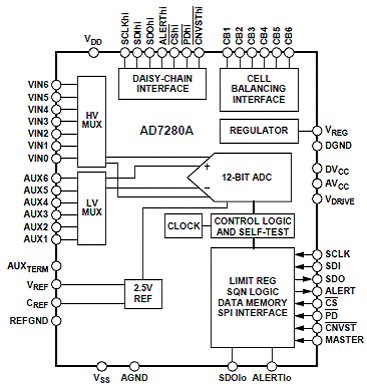
图1.AD7280A方框图 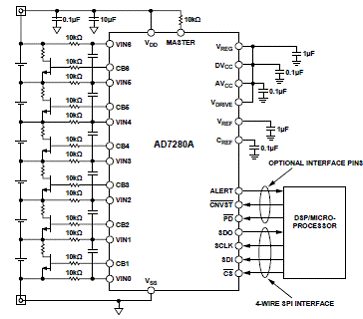
图2.AD7280A六电池组配置图 
图3.AD7280A菊花链配置图 Lithium ion (Li-Ion) battery stacks contain a large number of individual cells that must be monitored correctly in order to enhance the battery efficiency, prolong the battery life, and ensure safety. The 6-channel AD7280A devices in the circuit shown in Figure 1 act as the primary monitor providing accurate voltage measurement data to the System Demonstration Platform (SDP-B) evaluation board, and the 6-channel AD8280 devices act as the secondary monitor and protection system. Both devices can operate from a single wide supply range of 8 V to 30 V and operate over the industrial temperature range of −40℃ to +105℃. The AD7280A contains an internal ±3 ppm reference that allows a cell voltage measurement accuracy of ±1.6 mV. The ADC resolution is 12 bits and allows conversion of up to 48 cells within 7 μs. The AD7280A has cell balancing interface outputs designed to control external FET transistors to allow discharging of individual cells and forcing all the cells in the stack to have identical voltages. The AD8280 functions independently of the primary monitor and provides alarm functions indicating out of tolerance conditions. It contains its own reference and LDO, both of which are powered completely from the battery cell stack. The reference, in conjunction with external resistor dividers, is used to establish trip points for the over/undervoltages. Each cell channel contains programmable deglitching (D/G) circuitry to avoid alarming from transient input levels. The AD7280A and AD8280, which reside on the high voltage side of the battery management system (BMS) have a daisychain interface, which allows up to eight AD7280A’s and eight AD8280’s to be stacked together and allows for 48 Li-Ion cell voltages to be monitored. Adjacent AD7280A’s and AD8280’s in the stack can communicate directly, passing data up and down the stack without the need for isolation. The master devices on the bottom of the stack use the SPI interface and GPIOs to communicate with the SDP-B evaluation board, and it is only at this point that high voltage galvanic isolation is required to protect the low voltage side of the SDP-B board. The ADuM1400, ADuM1401 digital isolator, and the ADuM5404 isolator with integrated dc-to-dc converter combine to provide the required eleven channels of isolation in a compact and cost effective solution. The ADuM5404 also provides isolated 5 V to the VDRIVE input of the lower AD7280A and the VDD2 supply voltage for the ADuM1400 and ADuM1401 isolators. 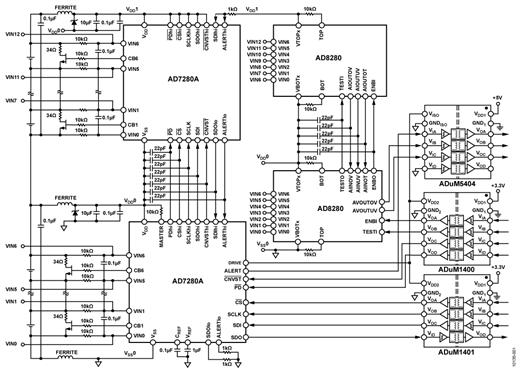
图4.AD7280A锂电池组检测和保护系统简化电路图 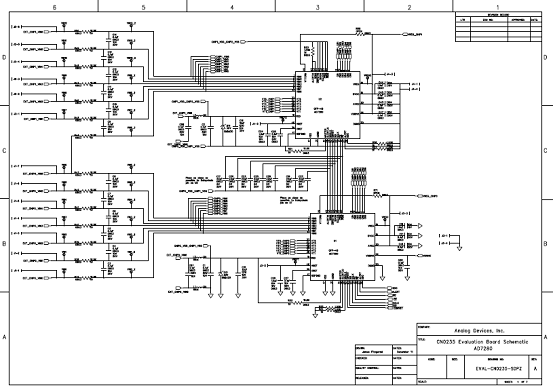
图5.EVAL-CN0235-SDPZ-PADSS电路图(1) 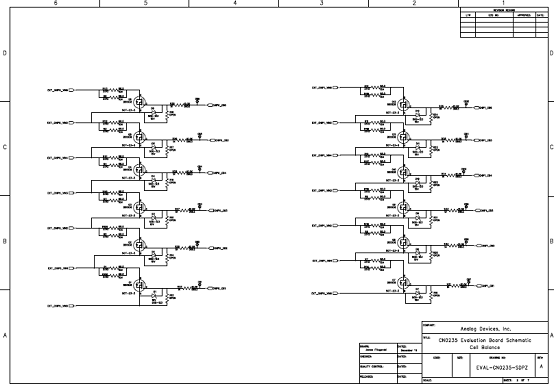
图6.EVAL-CN0235-SDPZ-PADSS电路图(2) 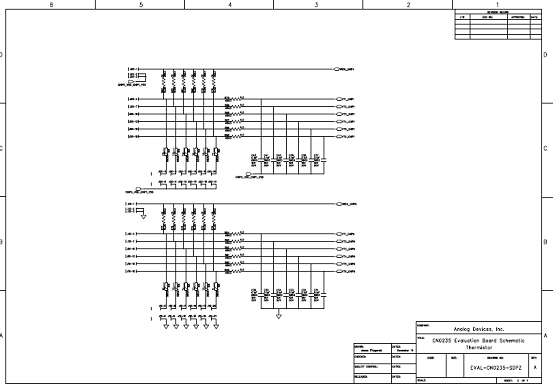
图7.EVAL-CN0235-SDPZ-PADSS电路图(3) 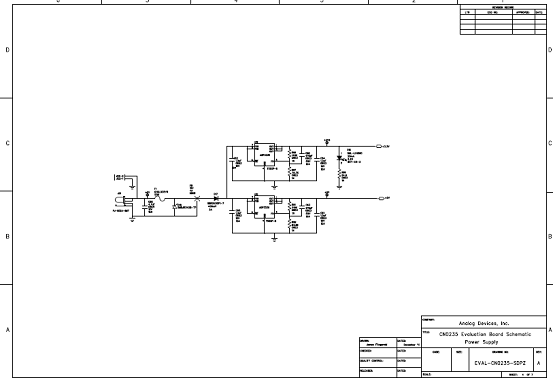
图8.EVAL-CN0235-SDPZ-PADSS电路图(4) 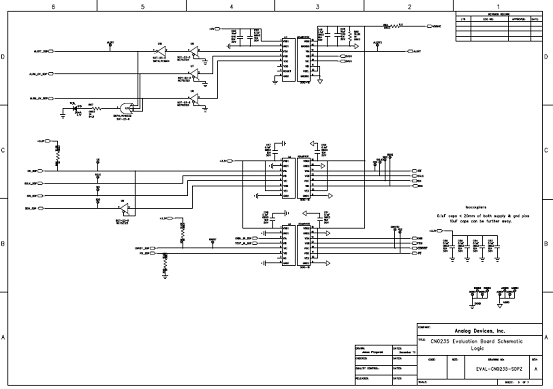
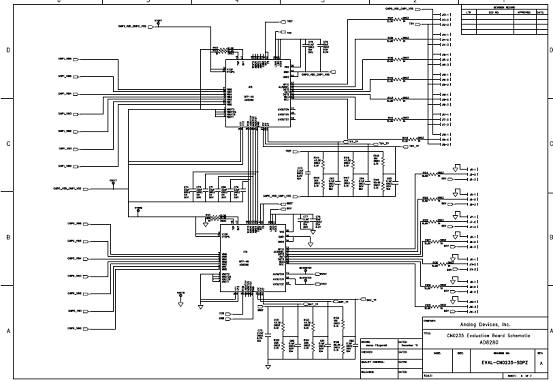
图9.EVAL-CN0235-SDPZ-PADSS电路图(5) 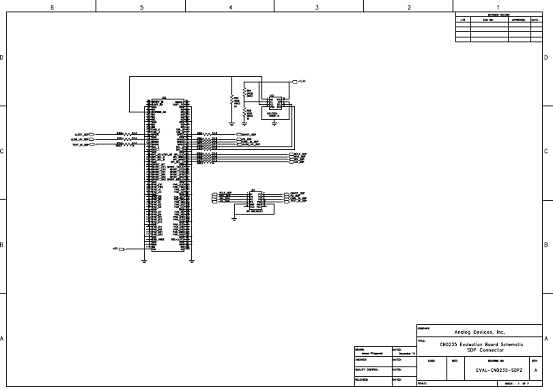
图10.EVAL-CN0235-SDPZ-PADSS电路图(6) 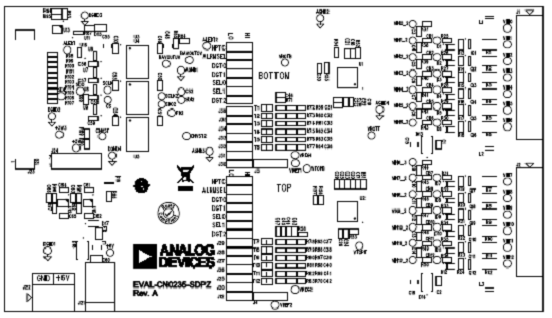
图11.EVAL-CN0235-SDPZ-PADSS评估板PCB布局图 EVAL-CN0235-SDPZ材料清单见: 
 EVAL-CN0235-SDPZ材料清单.rar
(24.15 KB)
EVAL-CN0235-SDPZ材料清单.rar
(24.15 KB)
详情请见:  AD7280A[2].pdf
(864.01 KB)
AD7280A[2].pdf
(864.01 KB)
 CN0235[2].pdf
(849.82 KB)
CN0235[2].pdf
(849.82 KB)
|







网友评论